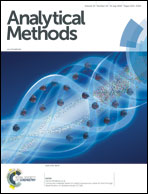Preparation of an OTA aptasensor based on a metal–organic framework†
Abstract
A novel aptasensor for ultrasensitive and rapid detection of ochratoxin A (OTA) was developed using a metal–organic framework (MOF) as the signal unit. In this work, a MOF was utilized as the signal probe. The signal probe differs from traditional probes; the signal of the cadmium ions (Cd2+) from the MOF can be directly detected without acid dissolution and preconcentration, greatly simplifying the detection steps and reducing the detection time. Moreover, the MOF contains large amounts of Cd2+ ions, which could provide high electrochemical signals. Our report is the first time using an MOF as the electrochemical signal probe for an aptasensor application. A gold nanoparticle (Au NP)-doped molybdenum disulfide (MoS2) nanocomposite was employed as an immobilized matrix for the sensor because of its high electronic conductivity. Under the optimized experimental conditions, an ultrasensitive aptasensor for the detection of OTA exhibited a wide linear range of 0.05–100 ng mL−1 with a low detection limit (LOD) of 10 pg mL−1 OTA (at 3σ). With these merits, this stable, simple, low-cost, sensitive and selective electrochemical aptasensor shows promise for applications in environmental monitoring.



 Please wait while we load your content...
Please wait while we load your content...